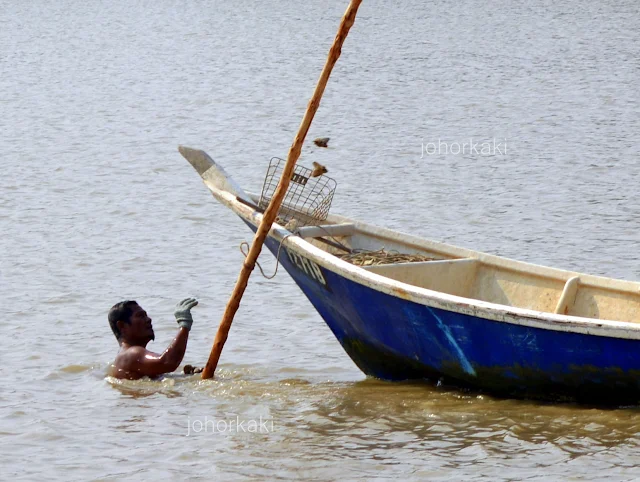
The first time I heard about Muar oysters was from the lady boss of Ah Hua kway teow thng at Jalan Segget in old downtown Johor Bahru 🦪

Ah Hua at Jalan Segget is famous for their RM16 fully loaded kway teow thng (now RM20 in 2023). The lady boss proudly told me that "I use only Muar oysters. More expensive but the best."
Muar oysters were already a well known, much sought after delicacy
even during the 1800s. The best of the best Muar oysters were reserved for the Sultan of Johor and people close to him. It is a species identified as Crassostrea (Magallana) Saidii.
 |
| The Straits Times 1886 |
The pleasures of Muar oysters were highly sought after by the 1870s. People were going to Muar for oysters, the way Singaporeans go all over Malaysia for durians today.
The old oyster beds were near Masjid Jamek Sultan Ibrahim Muar and Istana Muar at the mouth of Muar River. The mosque was built in 1887 by fishermen in gratitude for the divine blessing of oysters.
 |
| Eastern Daily Mail 1906 |
Muar oysters were awaited in great anticipation by the well heeled in Singapore.
Back in 1960, most of the oysters fished in Muar were sent to Singapore, shelled and its flesh sold at $3.50 per kilo in the markets. Each oyster diver made a princely sum of about $5 per day at that time.
You can imagine how excited I was to have a chance to see oyster
divers in action in the Muar River during the Muar Food Trail by Tourism
Malaysia Johor in 2013.

We boarded a ferry boat at the Tanjung Emas jetty to link up with the divers' sampans at the Muar River mouth.

The divers start work each day when the tide is low. Coming out in groups in motorised sampans. These oyster divers are from families which have been diving for oysters here for generations.

The diver heaved himself high above the water to take a long, deep breath. The divers dive just by holding their breath under water - no breathing apparatus, not even goggles are used.

The divers then disappeared under the water. The only things still visible were the sampans and the long wooden poles. As the current was swift in the Muar River, the boats continued to drift at a fast clip towards the sea while the divers were looking for oysters. The divers used the long poles to guide themselves down and up the oyster bed.


A few minutes later, the diver surfaced and threw the oysters he caught into the sampan. Clearly a demanding job that demands great strength and endurance.
Oyster diving is a sunset vocation with less than a dozen oyster divers today.

A middle man with a freshly caught oyster. At the time of writing, the divers sold the oysters to the middle man at RM20 per kilo (in 2013). This seems like quite a fair price for the divers' hard work, considering how heavy oyster shells are.

The Muar oyster that I ate straight from the Muar River bed. The slippery oyster was soft, fat, juicy, briny and very creamy.

A middle man with a freshly caught oyster. At the time of writing, the divers sold the oysters to the middle man at RM20 per kilo (in 2013). This seems like quite a fair price for the divers' hard work, considering how heavy oyster shells are.

The Muar oyster that I ate straight from the Muar River bed. The slippery oyster was soft, fat, juicy, briny and very creamy.
A popular way to enjoy Muar oysters is to make oyster omelette known as orh luak 蠔烙 in Teochew Chinese.
The delicious orh luak tastes of oyster umami, savoury, briny and sweet complemented by egginess, lard and aroma from chopped scallion.
Written by Tony Boey on 27 Jun 2013 | Updated: 23 Oct 2021

.jpg)



I didn't know there is a oyster farm in Muar. This is very educational and great post. Thanks.
ReplyDeleteThis is new to me too :P The oysters are wild and divers have been harvesting the oyster beds for at least over 100 years.
DeleteWow interesting....thanks for the information, hope the trade can continue and the pollution will not take a toll on it
ReplyDelete- Steven
I hope so too. The water looks brown.
DeleteCan we buy the oyster? Any address?
ReplyDeleteI am not sure. They are all sold to middlemen.
Deletehi, how can i find the contacts? can you provide me the contacts?
ReplyDeleteMy apologies Yafu. I don't have the info.
Delete